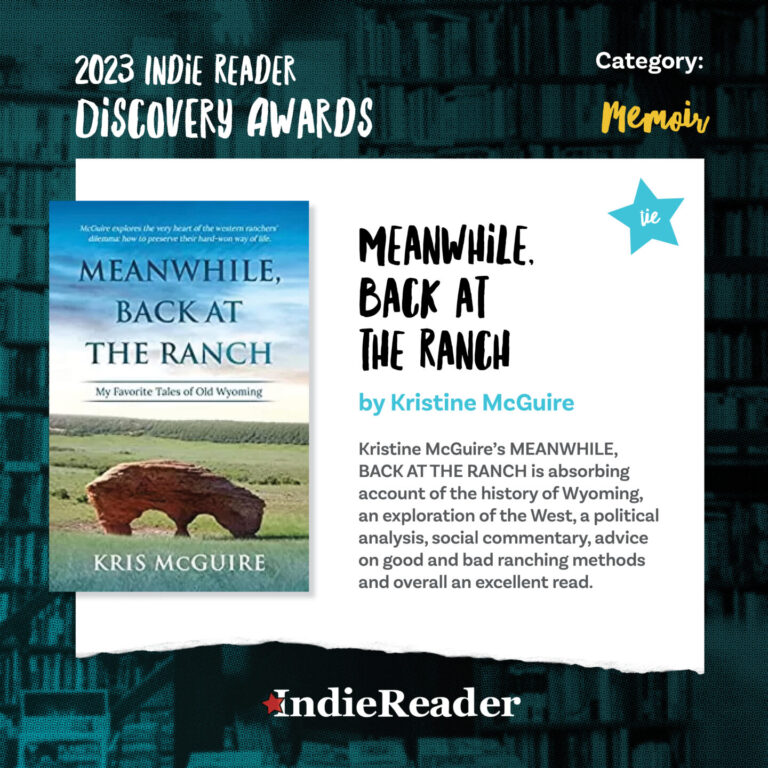Meanwhile, Back at the Ranch: My Favorite Tales of Old Wyoming was a winner in the MEMOIR category of the 2023 IndieReader Discovery Awards, where undiscovered talent meets people with the power to make a difference.
Following find an interview with author Kristine Mcguire.
What is the name of the book and when was it published?
Meanwhile, Back at the Ranch: My Favorite Tales of Old Wyoming was first published in 2019.
What’s the book’s first line?
“When my husband and I purchased the Old Oxford Horse Ranch, it consisted of two-and-a-half acres of land, about 1,600 acres; small compared to the surrounding spreads.”
What’s the book about? Give us the “pitch”.
My narrative first describes my family’s efforts to prevent the collapse of National Historic Site #236 (Barn at the Old Oxford Horse Ranch). A few years later, while standing on the pioneer trail between Laramie and Cheyenne, Wyoming, we discovered a signature rock on the back side of the ranch, so we began historically exploring its inscribed names to add to the ranch history.
Eighteen almost two-hundred-year-old mysteries have been solved by sleuthing through archives, newspapers, and published works. The folks who scratched their initials were not rich or famous; some might have gone unnoticed but for this book. Each chapter elaborates the life and times of that lonely traveler who stopped in the shade of my isolated, buffalo-shaped, crimson arch. The 1883 G. Mueller (heart) Bell[e] Kuster inscription drove me to the Albany County Library Wyoming Room, where I discovered a treasure trove of information about their frantic search for Belle’s grandmother. BER 1812 ranks among the earliest in the state, a tale that proved more difficult to tease out. Simply put, the book is the memoir of a rock as well as a documentary on the essence of Wyoming, good and bad.
The text spotlights everyday occurrences in the 1800s; the trials and tribulations of mountain men engaged in the beaver trade, the extra-judicial murder of suspected horse thieves, rustlers, and Native Americans, the fencing and overuse of public land, the abuse of government programs designed to populate an arid land with white settlers, and the role ranching and land development played in the development of a state. Good or bad, it is essential to be aware of ancient history before repeating it.
What inspired you to write the book? A particular person? An event?
My inspiration was the egregious disregard for scientific and historic truths embraced by my god-fearing, upstanding, and generous neighbors.
What’s the most distinctive thing about the main character? Who-real or fictional-would you say the character reminds you of?
The main character is an ancient sandstone monument that has existed for several millennia. I knew truths would be revealed if I listened hard enough to the ghosts of those who inscribed the rock.
What’s the main reason someone should really read this book?
Most people know little to nothing about Wyoming or its iconic ranching industry. Truthfully, little has changed in 150 years; that is a good thing as well as a bad thing.
If they made your book into a movie, who would you like to see play the main character(s)?
Brad Pitt as Arthur Whitehouse, Tom Hanks as Jacques LaRamie, Tommy Lee Jones as Ed Robinson, Christian Bale as John Gunnison, Robert Redford as Jim Bridger, Damian Lewis as L.P. Bradley, Claire Daines as Belle Kuster, Morgan Freeman as Bronco Sam, Glenn Close as Mary Powell, Meryl Streep as Mary Langoff, Maggie Smith as Esther Morris, Kevin Costner as M.C. Brown.
When did you first decide to become an author?
I first entertained the thought of publishing the volumes of trivia I gathered about these historical friends in 1995, but the computer holding the only file copy crashed. I revived the idea in 2006.
Is this the first thing you’ve written?
I submitted a twenty-page, typed television screenplay for I Spy (starring Robert Culp, Bill Cosby, and my best friend Polly) in 1964. The rejection letter was accompanied by a kind invitation to join the writer’s guild. I was twelve. Nothing between then and now.
What do you do for work when you’re not writing?
I am a grandmother, retired rancher, active pickleballer, avid birder, and keen environmentalist.
How much time do you generally spend on your writing?
I can spend eight hours a day typing away but that is bad for my hips.
What’s the best and the hardest part of being an indie?
The best part about being an Indie is there is no one bothering you. The worst part is that there is no one bothering you.
Would you go traditional if a publisher came calling? If so, why?
Yes. I need people passing through airport book stores to read this book before the next election.
Is there something in particular that motivates you (fame? fortune?)
I am motivated by the dramatic acceleration in climate change. What was predicted in 1970 has come true on steroids and something must be done before it is too late.
Which writer, living or dead, do you most admire?
Erik Larson.
Which book do you wish you could have written?

